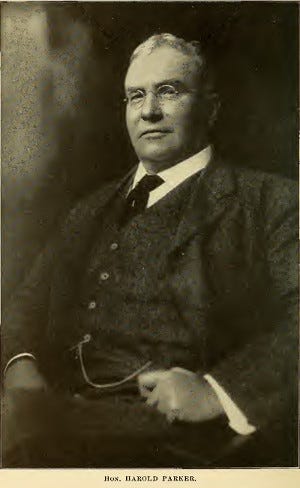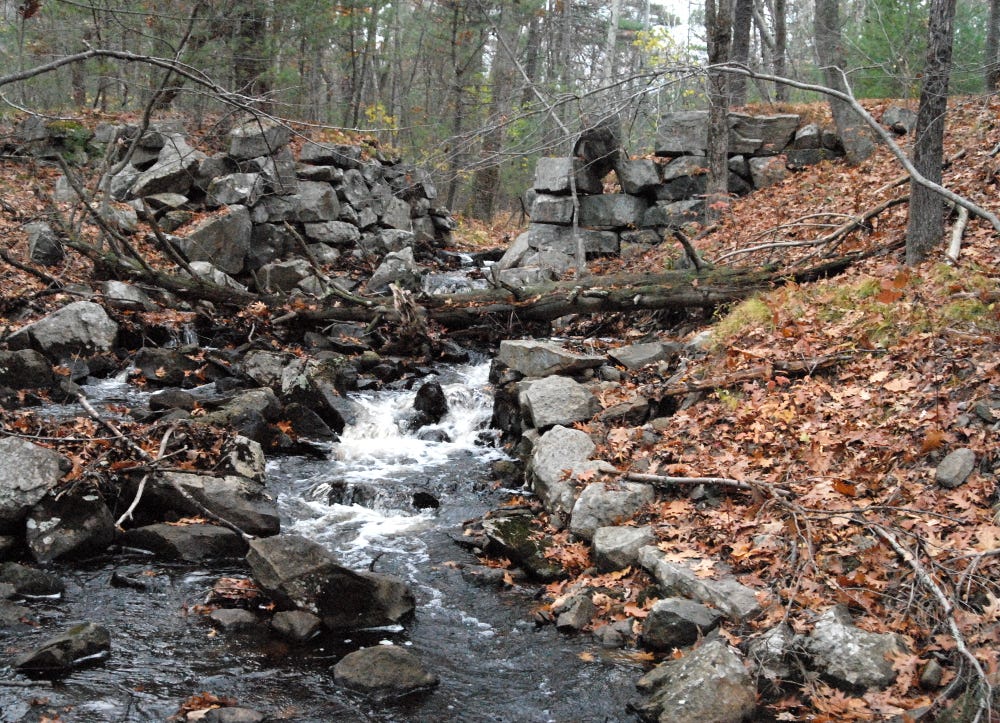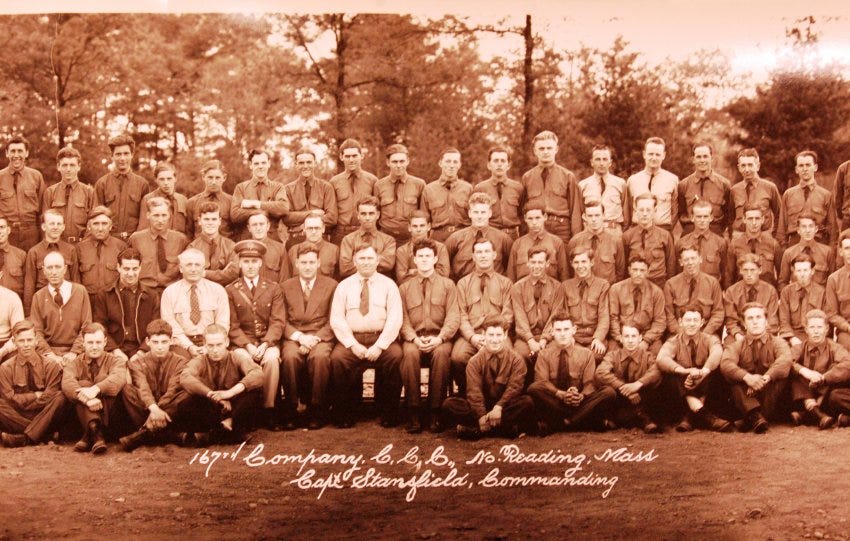On April 14, 1916, the newly-founded Massachusetts State Forest Commission filed thirteen deeds involving ten different families at the North Essex registry to establish Harold Parker State Forest.
We often think of this forest, the largest one in Andover, as only a place for recreation, and that’s partially true. The land west of Jenkins Road is set aside expressly for that purpose. The rest however is managed as a working forest in addition to recreation.
Much like at the federal level where there are national parks (e.g. Acadia National Park) and national forests (e.g. White Mountain National Forest), Massachusetts has state parks and state forests. National and state parks prioritize wildlife protection and recreation. National and state forests, while they also have many recreational opportunities, are resource management areas.1
When state officials, led by Harold Parker of the Forest Commission, identified the low plains in the southern part of Andover and North Andover as targets for acquisition, it was “a dry, bushy area filled with oak stump sprouts and suffering from much runoff of water from the soil.”2 The Boston Daily Globe called it “waste land.” Despite the land’s poor condition, the Forest Commission determined that it could become productive again if managed properly with government oversight.
Massachusetts wasn’t the only government body acquiring mismanaged forest land from private landowners. The Weeks Act of 1911 established the federal body that created the White Mountain National Forest in 1918.3 The Act responded to public outcry against deforestation, but also to a need to fill a material shortage and reduce reliance on foreign wood products.
Before the state created Harold Parker, the land supported many private farms and woodlots. That history goes back as far as 1695 when Peter Osgood (1663-1753), grandson of founding Andover settler John Osgood (1595-1651), claimed 400 acres between Berry Pond and the North Reading town line. He used the land to grow crops and raise livestock.
At the southeast corner of Osgood’s farm is a drumlin known as Osgood’s Hill. It once served as the boundary between Andover’s North and South Parish, established in 1709. Today a stone monument near the hill’s summit marks the point where Andover, North Andover, and North Reading intersect.
Running through the Osgood Farm is the Skug River and its tributaries, once a vital source of energy for mills. Mills emerged as Andover’s population spread out from the town center in the early 18th century. Some early homesteads in the Harold Parker area include the William Jenkins House (built 1765) and 53 Harold Parker Road (built 1720-1776).
Sawmills processed the wood harvested and at least three of these were located within Harold Parker’s boundaries. The foundations of two can be seen today, both built by the Jenkins family. One is on the Skug River behind the William Jenkins House and the other is near Harold Parker Road. The other known sawmills were also near Harold Parker Road. Prior to the park, the road was known as Sawmill Road or just Mill Road.
Quarrying was another industry once based here. The best known of these is Jenkins’ Quarry, also near the William Jenkins House. Founded in 1834, Jenkins and his partners mined blue soapstone. Jenkins was also an abolitionist, and his home was a stop on the Underground Railroad. Among other tactics, fugitive slaves may have disguised themselves as workers for Jenkins to evade capture.
In the late 19th century, overexploitation of the forest reached its height. Neighboring towns such as Lawrence and Haverhill demanded more lumber and larger companies bought land and increased production. Without proper management, they extracted more than could replenish and eventually ran out. Fires were frequent and invasive species hurt native tree survival.
It was at this point that the public took notice and demanded increased regulation on and access to natural resources. The 1890s saw the inception of groups like the Trustees of Reservations, the Massachusetts Audubon Society, and the Andover Village Improvement Society.4
The period between 1890 and 1925 saw a major influx in conservation and resource management efforts. Harold Parker State Forest is a product of that movement and is named for one of its visionaries. Harold Parker was Chairman of the State Forest Commission and “dreamed of a system of lake and forest reservations stretching across the entire state of Massachusetts.”5 He died just months after the founding of the state forest and his colleagues named it in his honor.
The Parker forest grew quickly in its early years, soon containing thousands of acres in four towns. Relatively little took place in regard to recreation in its early years, perhaps for its characterization as a “waste land” and not a place of natural beauty.

That changed in 1933 when Roosevelt’s New Deal created the Civilian Conservations Corps (CCC). Young, unemployed men between ages 18 and 25 performed labor-intensive work for $30.00 per month on projects in Harold Parker State Forest and other reservations around the country.
The 110th company spent two years in Andover. They extended Harold Parker Road to Jenkins Road which required a bridge over the Skug River and added stone pillars to the entrance on Route 125. They also built dams and created four ponds in Andover: Field, Collins, Brackett, and Delano.
The second company in Andover was the 167th. They built the Lorraine Campground, park headquarters, Berry Pond Beach, and various trails, fire roads, and facilities. The 167th is responsible for the other five dammed ponds in the forest: Stearns, Salem, Sudden, Frye, and Bradford. Both companies managed the timber resources, but the 167th stayed much longer.
Logging continued after the 167th left in 1941. The state would sometimes harvest and other times allow private individuals to do so themselves. The most recent harvest was in 2010.6 The CCC was also a catalyst for recreation, expanding opportunities for camping, fishing, hiking, canoeing, and other activities. A brief glance at a Harold Parker trail map reveals just how popular this state forest has become.
More Harold Parker CCC photos can be found at Digital Commonwealth.
Harold Parker State Forest webiste
North Shore Nature, “Harold Parker State Forest,” North Shore Nature, North Shore Nature, accessed July 10, 2021, https://www.northshorenature.com/harold-parker-state-forest-2/.
Juliet Haines Mofford, AVIS: A History in Conservation (Andover, MA: Andover Village Improvement Society, 1980), 67.
David Govatski, “Weeks Act and the Creation of the White Mountain National Forest,” WhiteMountainHistory.org: Telling the History of 200 years of White Mountain History, WhiteMountainHistory.org, accessed July 10, 2021, https://whitemountainhistory.org/Weeks_Act.html.
North Shore Nature, “Harold Parker State Forest.”
Mofford, AVIS: A History in Conservation, 67.
North Shore Nature, “Harold Parker State Forest.”








Just realized that the other man with his arms crossed is behind another man with a white shirt and tie. My Dad is the one with a smile on his face. He had that smile until the day he died. People used to comment about it. Gwen
I was especially interested in reading about Harold Parker Forest, as my father, Howard Alexander Young, was stationed there in the CCCs. I was really excited to see the picture of the young men in the picture. I picked out my Dad right away. He is behind the man in the white shirt. Looks like he has his arms crossed and has curly brown hair. Gwendolen Young Devoe